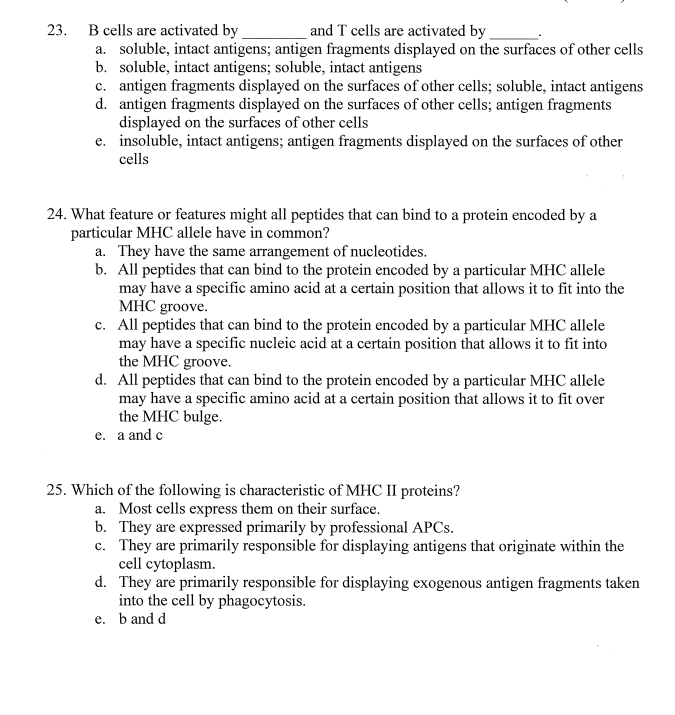B cells are activated by a. soluble, intact antigens; antigen fragments displayed on the surfaces of other cells b. soluble, intact antigens; soluble, intact antigens c. antigen fragments displayed on the surfaces of other cells; soluble, intact antigens d. antigen fragments displayed on the surfaces of other cells; antigen fragments displayed on the surfaces of other cells e. insoluble, intact antigens; antigen fragments displayed on the surfaces of other cells 23. and T cells are activated by
B cells are activated by a. soluble, intact antigens; antigen fragments displayed on the surfaces of other cells b. soluble, intact antigens; soluble, intact antigens c. antigen fragments displayed on the surfaces of other cells; soluble, intact antigens d. antigen fragments displayed on the surfaces of other cells; antigen fragments displayed on the surfaces of other cells e. insoluble, intact antigens; antigen fragments displayed on the surfaces of other cells 23. and T cells are activated by
Biology: The Dynamic Science (MindTap Course List)
4th Edition
ISBN:9781305389892
Author:Peter J. Russell, Paul E. Hertz, Beverly McMillan
Publisher:Peter J. Russell, Paul E. Hertz, Beverly McMillan
Chapter45: Defenses Against Disease
Section: Chapter Questions
Problem 1TYK
Related questions
Question
100%
Need answer of 23 and 24.

Transcribed Image Text:23.
and T cells are activated by
B cells are activated by
a. soluble, intact antigens; antigen fragments displayed on the surfaces of other cells
b. soluble, intact antigens; soluble, intact antigens
c. antigen fragments displayed on the surfaces of other cells; soluble, intact antigens
d. antigen fragments displayed on the surfaces of other cells; antigen fragments
displayed on the surfaces of other cells
e. insoluble, intact antigens; antigen fragments displayed on the surfaces of other
cells
24. What feature or features might all peptides that can bind to a protein encoded by a
particular MHC allele have in common?
a. They have the same arrangement of nucleotides.
b. All peptides that can bind to the protein encoded by a particular MHC allele
may have a specific amino acid at a certain position that allows it to fit into the
MHC groove.
c. All peptides that can bind to the protein encoded by a particular MHC allele
may have a specific nucleic acid at a certain position that allows it to fit into
the MHC groove.
d. All peptides that can bind to the protein encoded by a particular MHC allele
may have a specific amino acid at a certain position that allows it to fit over
the MHC bulge.
e. a and c
25. Which of the following is characteristic of MHC II proteins?
a. Most cells express them on their surface.
b. They are expressed primarily by professional APCS.
c. They are primarily responsible for displaying antigens that originate within the
cell cytoplasm.
d. They are primarily responsible for displaying exogenous antigen fragments taken
into the cell by phagocytosis.
e. b and d
Expert Solution
This question has been solved!
Explore an expertly crafted, step-by-step solution for a thorough understanding of key concepts.
Step by step
Solved in 3 steps

Knowledge Booster
Learn more about
Need a deep-dive on the concept behind this application? Look no further. Learn more about this topic, biology and related others by exploring similar questions and additional content below.Recommended textbooks for you

Biology: The Dynamic Science (MindTap Course List)
Biology
ISBN:
9781305389892
Author:
Peter J. Russell, Paul E. Hertz, Beverly McMillan
Publisher:
Cengage Learning

Biology (MindTap Course List)
Biology
ISBN:
9781337392938
Author:
Eldra Solomon, Charles Martin, Diana W. Martin, Linda R. Berg
Publisher:
Cengage Learning

Anatomy & Physiology
Biology
ISBN:
9781938168130
Author:
Kelly A. Young, James A. Wise, Peter DeSaix, Dean H. Kruse, Brandon Poe, Eddie Johnson, Jody E. Johnson, Oksana Korol, J. Gordon Betts, Mark Womble
Publisher:
OpenStax College

Biology: The Dynamic Science (MindTap Course List)
Biology
ISBN:
9781305389892
Author:
Peter J. Russell, Paul E. Hertz, Beverly McMillan
Publisher:
Cengage Learning

Biology (MindTap Course List)
Biology
ISBN:
9781337392938
Author:
Eldra Solomon, Charles Martin, Diana W. Martin, Linda R. Berg
Publisher:
Cengage Learning

Anatomy & Physiology
Biology
ISBN:
9781938168130
Author:
Kelly A. Young, James A. Wise, Peter DeSaix, Dean H. Kruse, Brandon Poe, Eddie Johnson, Jody E. Johnson, Oksana Korol, J. Gordon Betts, Mark Womble
Publisher:
OpenStax College

Biology 2e
Biology
ISBN:
9781947172517
Author:
Matthew Douglas, Jung Choi, Mary Ann Clark
Publisher:
OpenStax

Biology: The Unity and Diversity of Life (MindTap…
Biology
ISBN:
9781337408332
Author:
Cecie Starr, Ralph Taggart, Christine Evers, Lisa Starr
Publisher:
Cengage Learning

Biology: The Unity and Diversity of Life (MindTap…
Biology
ISBN:
9781305073951
Author:
Cecie Starr, Ralph Taggart, Christine Evers, Lisa Starr
Publisher:
Cengage Learning